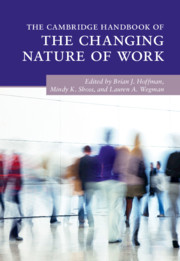Book contents
- The Cambridge Handbook of the Changing Nature of Work
- The Cambridge Handbook of the Changing Nature of Work
- Copyright page
- Contents
- Figures
- Tables
- Contributors
- Part I Introduction to the Changing Nature of Work
- Part II What Has Changed?
- Part III Implications for Talent Management and Impact on Employees
- 14 Implications of the Changing Nature of Work for Selection
- 15 Implications of the Changing Nature of Work for Recruitment and Retention
- 16 Performance Management and the Changing Nature of Work
- 17 Implications of the Changing Nature of Work for Training
- 18 Leader Behaviors and the Changing Nature of Work
- 19 The Changing Nature of Teams
- 20 Managing Employees across the Working Lifespan
- 21 Implications of the Changing Nature of Work for Employee Attitudes and Work Perceptions
- 22 Implications of the Changing Nature of Work for the Interface between Work and Nonwork Roles
- 23 Implications of the Changing Nature of Work for Employee Health and Safety
- 24 The Dark Side of Workplace Technology
- 25 Implications of the Changing Nature of Work for the Employee–Organization Relationship
- 26 The Future of Work
- 27 Sustainability as a Driver of Organizational Change
- Index
- References
25 - Implications of the Changing Nature of Work for the Employee–Organization Relationship
from Part III - Implications for Talent Management and Impact on Employees
Published online by Cambridge University Press: 02 April 2020
- The Cambridge Handbook of the Changing Nature of Work
- The Cambridge Handbook of the Changing Nature of Work
- Copyright page
- Contents
- Figures
- Tables
- Contributors
- Part I Introduction to the Changing Nature of Work
- Part II What Has Changed?
- Part III Implications for Talent Management and Impact on Employees
- 14 Implications of the Changing Nature of Work for Selection
- 15 Implications of the Changing Nature of Work for Recruitment and Retention
- 16 Performance Management and the Changing Nature of Work
- 17 Implications of the Changing Nature of Work for Training
- 18 Leader Behaviors and the Changing Nature of Work
- 19 The Changing Nature of Teams
- 20 Managing Employees across the Working Lifespan
- 21 Implications of the Changing Nature of Work for Employee Attitudes and Work Perceptions
- 22 Implications of the Changing Nature of Work for the Interface between Work and Nonwork Roles
- 23 Implications of the Changing Nature of Work for Employee Health and Safety
- 24 The Dark Side of Workplace Technology
- 25 Implications of the Changing Nature of Work for the Employee–Organization Relationship
- 26 The Future of Work
- 27 Sustainability as a Driver of Organizational Change
- Index
- References
Summary
Many writings on the changing nature of work portray the employee–organization relationship as a casualty of the modern workplace. This chapter reviews social exchange models of the employee–organization relationship as captured in organizational support and psychological contract theories. We explore the evidence of the extent to which the employee–organization relationship has changed as a result of changes in employment practices over the past several decades. Our analysis considers both overall trends in the employee–organization relationship as well as specific issues tied to temporary and part-time work, independent contractors, tripartite employment relationships, job insecurity, job hopping, and income inequality. The evidence suggests that while certain employment practices threaten the quality of the employee–organization relationship, social exchange models provide useful and relevant frameworks through which to understand the nature of these changes and employees’ reactions to them.
Keywords
- Type
- Chapter
- Information
- The Cambridge Handbook of the Changing Nature of Work , pp. 532 - 554Publisher: Cambridge University PressPrint publication year: 2020



